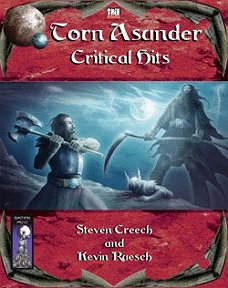
Do you find combat a bit mechanical, just chipping away at your adversaries' Hit Points (HP) until they fall over? And can you really imagine describing to your mates over a drink about how someone once managed to do 25 HP of damage to you... but you killed them with a mighty blow that dealt out 30 HP in return? Not very realistic, and if you would prefer rather more graphic descriptions of battle injuries, you've come to the right place.
The Introduction explains how this book is intended to bring excitement and realism to combat... and maybe even deter player-characters from taking excessive risks. 'You lose a leg' sounds a lot worse than 'You take 20 HP damage', after all. It also outlines the contents, beginning with the rules to make it all happen and then building on them with material on healing, armour, prestige classes, new spells, equipment, weapons and monsters. All you need to make combat memorable... and deadly.
Firstly, Critical Hits notes how in real life, most people will only use violence as a last resort because of the chance of getting hurt... unlike the average role-playing game character, who wades in regardless, with the player feeling no pain even as the character's HPs reduce. In this system, when you get a critical hit, as well as dealing out HP damage as normal, you also deliver a 'Critical Effect'. That's when it gets graphic... and downright nasty. It adds a bit more complexity, there are extra die rolls to make, but you may find that it's worth it in making combat more dramatic. Basically, a Critical Effect can be mild, moderate or serious, depending on how much over the minimum you needed to hit you got. Then you determine which part of the foe's body you hit, and apply an appropriate Critical Effect based on the sort of damage (crushing, piercing, etc.) your weapon does. It sounds more complex than it is, especially when you remember that it only happens with a critical hit anyway. The one thing that might have improved it is a table of Critical Effects rather than a lot of narrative to plough through to find the apposite one. There are a lot of variant cases, to accommodate monsters with wings, tails, or lots of legs and the like; with a system of 'body profiles' to determine what is the most appropriate 'which body part did I hit?' table to use. Oh, and you may call shots if you have an urge to chop off your foe's tail or whatever - but this reduces your chance to hit.
Next, Healing and Helping takes a look at how dealing out damage in this way affects recovery from injury. In particular it highlights non-magical healing, making the Heal skill much more intersting. There's a bit about using herbs too (an extract from the book Alchemy and Herbalism from the same publisher). Magical healing is also covered, and there's a note about scars. A new healing tool, the practise of acupunture, is introduced, and there are extensive notes on the equipment would-be healers need to have. There's druidical lore, new healing spells, and - should all else fail - artificial limbs.
The rest of the book contains more useful material like extensive notes on armour and how it can protect you against critical effects; the marksman, spirtual healer and apothecary classes; new feats and spells and weapons; and finally some new monsters and templates.
The material herein certainly makes combat more realistic and visceral, empowering vivid descriptions; whether or not the overheads in terms of extra die rolls is worth it willl be up to you and your group to decide.
Return to Torn Asunder: Critical Hits page.
Reviewed: 18 October 2019

